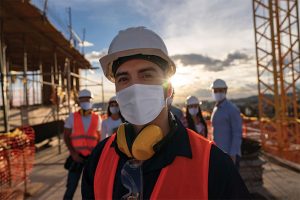By Karyn Salerno and Cal Beyer
The phrase “the elephant in the room” refers to an issue that is too large to ignore or sweep under the carpet and have the potential to be disruptive if left unaddressed. These issues apply as much in our personal lives outside of work as it does in the workplace. A major reason organizations (and families) do not address these “elephants in the room” is the fear of the unknown, including the unknown ripple-effects of addressing the issue being overlooked. One such “elephant in the room” in the construction industry is alcohol and substance misuse among the collective workforce.
Why Alcohol and Substance Use Is “An Elephant in the Room”
The data is too important to ignore. According to the Substance Abuse Mental Health Services Administration (SAMHSA), the construction industry workforce has the second-highest rate of heavy drinking, described as 5-7 drinks in a single setting. Moreover, data from Quest Diagnostics annual Drug Testing Index continues to show concerning substance misuse trends in construction, among other industries, including rising positive tests for marijuana, post-accident tests and among federally regulated safety-sensitive positions. (See Resources for more information.) Unfortunately, similar data does not exist for alcohol tests. From the data on substance misuse, it can be argued that a comprehensive substance use testing program is no longer adequate for deterring substance misuse.
Why the “Elephant in the Room” Can No Longer Be Ignored
The consequences are too great to not address substance misuse by workers. First and foremost, the safety of the workforce and the general public is at risk. Despite the decreasing rates of recordable and lost time injury case rates, the frequency of serious injuries and fatalities continues to remain stable over the past two decades. Many safety, human performance and well-being professionals are focusing on “what’s under the hardhat” to explain this phenomenon.
The role of fatigue, impairment and distraction from substance misuse must be considered while also recognizing that work and schedules may compound this fatigue and mental stress. Work schedules and the challenge of production may create and foster unexpected substance use while coping with long hours, time away from home, isolation and out of town work. More needs to be done to help educate the workforce, including supervisors and leaders, about the importance of substance misuse and the associated complications of “what’s under the hardhat. ”
Why the “Elephant in the Room” Can No Longer be Accepted
Chris DeHerrera, CEO of the Associated Builders and Contractors of Utah, cited statistics from ABC’s 2020 Safety Performance Report showing that “one-third of all incidents on construction job sites are drug-or alcohol-related. ” DeHerrera continues, “Substance abuse programs and policies with provisions for drug and alcohol testing where permitted lead to a 66% reduction in TRIR and a 67% reduction in DART rates and can be an effective method of incident prevention if used properly. ”
Bryan McCurdy, human resources director for Lakeview Rock Products in North Salt Lake, Utah, states, “We have accepted a problem that should not be an acceptable problem. Why are we willing to accept these behaviors? Is it because the behaviors are not affecting us all the time?”
Calling out the “Elephant in the Room”
A “gut-check” question company leaders must consider is, “are you accepting substance misuse because behaviors may not manifest as an immediate issue or problem”? If that is not compelling enough, then leaders should also consider the potential effects substance misuse can have on key operational factors, including productivity, schedule, job site safety, quality and rework, owner concerns or delays, and profitability.
To make matters even more real, in a Construction Executive article titled “Opioid and Substance Abuse in the Construction Industry,” author Marko Kaar states there are more deaths by suicide and opioid overdoses in the AEC industry than those attributed annually to OSHA’s Focus Four. Armed with this information, contractors need to expand the level of behavioral health literacy to understand the true direct and (hidden) indirect consequences of substance misuse. DeHerrera also asserts, “the stigma of mental and emotional health in the construction industry has stifled the conversation for many years. ”
Finding Solutions for the “Elephant in the Room”
The construction industry must continue to illuminate the problem through education and training while continuing to develop solutions. For example, construction employers are right to be concerned with opioids for the treatment of chronic pain for musculoskeletal injuries to trades workers. Travelers Chief Medical Director Dr. Marcos Iglesias echoes this concern, stating, “The tools we use for treating acute pain are not effective in managing chronic pain, and there is no silver bullet that works in all cases. ”
Dr. Iglesias shared that the “approaches that introduce active techniques and equip workers to manage their chronic musculoskeletal pain are most effective. ” Dr. Iglesias shared numerous such examples, including “physical activity, pain management education, sleep restoration and behavioral approaches, such as fear-avoidance behavioral therapy, cognitive behavioral therapy, and acceptance and commitment therapy. ” Dr. Iglesias concluded, “Since there are multiple options to manage chronic pain, it’s important that you have a shared philosophy with your insurance carrier in order to help employees recover functionally from an injury. ”
Again, Dr. Iglesias offered perspective for employers on the most important steps to address substance use among employees. Iglesias said, “Effectively addressing substance use in the workplace requires a strong commitment from management, human resources, supervisors and employees and a coordinated approach to ensure that policies, education, training and support align. ” Dr. Iglesias elaborated on the importance of “a common purpose and sense of accountability being crucial to making a program successful. ” Dr. Iglesias recommends “making information available on the risks of misusing alcohol and drugs, how to avoid misuse and how to improve physical and mental well-being. ”
Conclusion
DeHerrera believes “we must have the vital conversations in order to promote the solutions and resources for the entire AEC industry. It’s imperative that we continue the educational process for company leaders. ” It is important to keep employees from slipping through the cracks by encouraging and equipping them to seek help. There needs to be greater recognition that alcohol or substance misuse may be the result of another problem or unresolved issue. It is time to incorporate more about worker’s mental health and well-being into job site safety. It’s time to focus on the holistic health in construction safety AND health.

Resources
Kaar, Marko. (Aug. 24, 2018). Opioids and Substance Use Disorders in the Construction Industry. Construction Executive.
https://www.constructionexec.com/article/opioids-and-substance-use-disorders-in-the-construction-industry
National Safety Council. (2020). Opioids at Work Toolkit for Employers. https://safety.nsc.org/rxemployerkit
Quest Diagnostics. (Sept. 11, 2019). Workforce Drug Positivity Increases in More Than One-Third of U. S. Industry Sectors Examined. According to Quest Diagnostics Multiyear Analysis. https://www.questdiagnostics.com/home/physicians/health-trends/drug-testing/industry-insights/
Quest Diagnostics. (April 11, 2019). Workforce Drug Testing Positivity Climbs to Highest Rate Since 2004, According to New Quest Diagnostics Analysis. https://www.questdiagnostics.com/home/physicians/health-trends/drug-testing/
Karyn Salerno is a risk and safety specialist for CSDZ in Salt Lake City. She has extensive experience in construction safety and risk management working with construction contractors and associations in the western United States. She is partnering with contractors to address physical safety and behavioral health issues. Contact Salerno at ksalerno@csdz.com or 801-910-8436.
Cal Beyer is vice president of workforce risk and worker well-being for CSDZ in Minneapolis, Minnesota. He is a Certified Wellness Practitioner (CWP). He is a member of the Executive Committee of the National Action Alliance for Suicide Prevention and the Expert Advisory Group of the Center for Workplace Mental Health. Cal was instrumental in the launch of the Construction Industry Alliance for Suicide Prevention. Contact Beyer at cbeyer@CSDZ. com or 651-307-7883.
Reprinted from constructionexec.com, September 30, 2020, a publication of Associated Builders and Contractors. Copyright 2020. All rights reserved.
This story appears in Issue 4 2019-2020 of On The Road Magazine.







